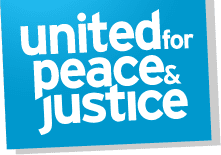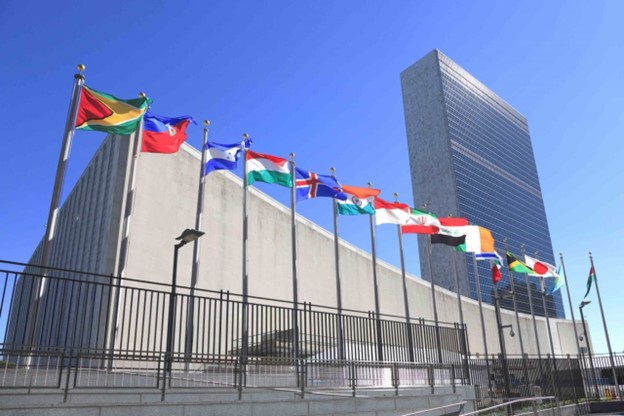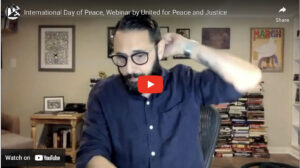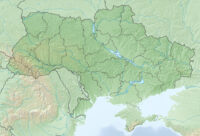Jackie Cabasso, Executive Director, Western States Legal Foundation; National Co-convener UFPJ*
The Second Meeting of States Parties to the Treaty on the Prohibition of Nuclear Weapons (TPNW) took place from November 27 – December 1, 2023 at United Nations Headquarters in New York City. Underscoring the catastrophic humanitarian consequences that would result from any nuclear weapons use, the TPNW prohibits states parties from developing, testing, producing, manufacturing, transferring, possessing, stockpiling, using, or threatening to use nuclear weapons, allowing nuclear weapons to be stationed on their territory, or assisting others in engaging in these activities. To date, there are 93 signatories and 69 states parties, none of them nuclear-armed. Unfortunately, the TPNW is opposed by the nuclear-armed states and is binding as such only on those states which have signed and ratified it.
The TPNW meeting served as the centerpiece of a wide range of nuclear disarmament activities. Some 700 individuals, representing over 100 nongovernmental organizations took part in a dynamic, interactive process with the member states. In what could be viewed as a much broader, week-long nuclear disarmament conference, more than 65 side events, including panel discussions, art exhibitions, concerts, and awards ceremonies were held inside the UN and around New York City.
For example, on the first day of the meeting, 23 members of Parliamentarians for the TPNW, from 14 countries that have not yet signed the treaty, met on the margins of the conference and delivered a statement denouncing nuclear threats while urging governments to sign and ratify the TPNW. Among them was Congressman Jim McGovern (D-MA), who is the lead sponsor of H. Res 77,“Embracing the goals and provisions of the Treaty on the Prohibition of Nuclear Weapons.” During the course of the day, Rep. McGovern met with the Mayors of Hiroshima and Nagasaki, who headed a Mayors for Peace delegation including Mayor Frank Cownie of Des Moines, Iowa, the U.S. Vice-President of Mayors for Peace. Mayor Cownie was the lead sponsor of a resolution adopted by the U.S. Conference of Mayors at its annual June meeting, “Calling for Urgent Action to Avoid Nuclear War, Resolve the Ukraine Conflict, Lower Tensions with China, and Redirect Military Spending to Meet Human Needs.” The resolution calls on Congress to pass H. Res. 77. The Mayors of Hiroshima and Nagasaki also delivered statements to the states parties to the TPNW.
Compared to the rancorous August meeting of the States Parties to the Nuclear Nonproliferation Treaty (NPT), which could not even agree on a Chair’s factual summary report, the TPNW meeting manifested a unified and unambiguous recognition that growing threats of nuclear war are intolerable and that the only solution is the total elimination of nuclear weapons.
It is evident that even though the TPNW cannot achieve nuclear disarmament without the participation of the nuclear-armed states, its members are energetically using it as a platform to develop and disseminate information and analysis that is valuable in the broader global context. Examples of this were the report on gender impacts, including the disproportionate effects of radiation on women and girls’ health, and the first report of the Scientific Advisory Group on developments regarding nuclear weapons, nuclear weapon risks, the humanitarian consequences of nuclear weapons, nuclear disarmament, and related issues. The Scientific Advisory Group also called for a new UN study on the consequences of nuclear war, given the last comprehensive studies were done in the late 1980s.
In an important development, states parties, for the first time, mandated member states, the International Committee of the Red Cross, the International Campaign to Abolish Nuclear Weapons (ICAN) and other stakeholders and experts to engage in consultations to “challenge the security paradigm based on nuclear deterrence by highlighting and promoting new scientific evidence about the humanitarian consequences and risks of nuclear weapons and juxtaposing this with the risks and assumptions that are inherent in nuclear deterrence,” and to present their findings at the third meeting of States parties in March 2025.
The Latin root of the word deterrence means to “frighten away, fill with fear.” In other words, to threaten. Deterrence undergirds entire military-industrial establishments and the national security states and elites they serve. It is an ideology which has outlived its Cold War origins and is used by nuclear-armed states to justify the perpetual possession and threatened use – including first use – of nuclear weapons.
Over half the world’s population lives in countries whose national security postures explicitly depend on nuclear weapons and the doctrine of “nuclear deterrence.” In my view, nuclear deterrence is the Gordian knot blocking the path to nuclear disarmament.
The hard truth is that neither the NPT nor the TPNW can achieve disarmament until the nuclear-armed states are willing to reimagine a global system that puts universal human security above the narrow interests of “national security” enforced by nuclear coercion – euphemistically called deterrence.
For more details about the Second Meeting of States Parties to the TPNW, read ICAN’s Outcome Summary report.
Read the Political Declaration adopted by the states parties.
Read the Package of Decisions adopted by the states parties.
Read Statements and Documents and Reports by member states and nongovernmental organizations.
*Note: Most of these reflections are quoted in an article, “Nuclear Deterrence: An Unproven Gamble that Risks Humanity,” published by IDN-InDepthNews on Dec. 3, 2023



